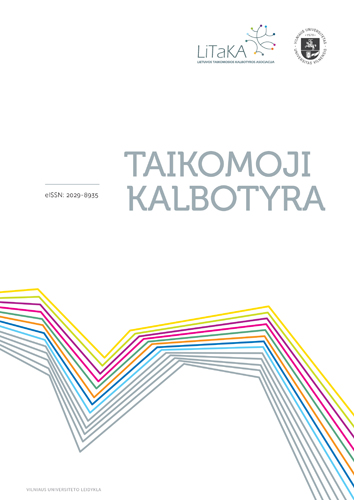Metaphor identification procedure MIPVU: an attempt to apply it to Lithuanian
Metaphor identification procedure MIPVU: an attempt to apply it to Lithuanian
Author(s): Justina UrbonaitėSubject(s): Cognitive linguistics, Baltic Languages
Published by: Vilniaus Universiteto Leidykla
Keywords: metaphor; metaphor identification procedure; Pragglejaz; MIPVU;
Summary/Abstract: Recently metaphor researchers have addressed important points of criticism regarding some methodological weaknesses and have developed a new tool of metaphor identification, the so called MIP tool and its refined version MIPVU. The procedure has been designed to identify metaphor in English, yet, numerous metaphor researchers have applied it to other languages. The aim of this study was to test the MIP(VU) procedure in identifying linguistic metaphor in Lithuanian and discuss some problematic areas as well as provide tentative suggestions to solving them. The most relevant issues in the application of MIP(VU) to Lithuanian were the identification of metaphorical meaning generated by grammatical cases, demarcation of lexical units, establishment of the contextual and the basic meaning of words based on their definitions provided in dictionaries of Lithuanian and the fuzzy boundaries between homonymy and polysemy. Firstly, difficulty may arise in identifying metaphorically used nouns the metaphoricity of which is generated by grammatical cases. Since MIP(VU) tool does not provide a solution for identifying metaphoricity which is case-induced, a researcher may need to make adjustments to the procedure or disregard metaphoricity generated by such grammatical cases as the locative or the instrumental. To develop an adjusted MIP(VU) procedure which would include steps of tackling grammar-induced metaphoricity in Lithuanian would require linguists’ collaboration yet it could prove to be an effective undertaking.Secondly, in marking lexical units for metaphor in Lithuanian difficulties may occur in demarcating lexical units. The most common difficulty was concerned with demarcating polywords and some proper nouns, especially law-related terms such as names of institutions or documents which often consist of many words. As a suggestion, for more effective prospective application of the procedure it may be helpful to include proper nouns into contemporary dictionaries of Lithuanian. Since they designate a single referent at the conceptual level, it is fair to treat them as individual units of analysis.Thirdly, Lithuanian researchers may face difficulty in the procedural step of establishing contextual and basic meanings of the words, namely, in singling out one basic meaning from all listed in the dictionary. However, sometimes two or more senses provided in the dictionary may be equally suitable in meeting the criterion of being more basic, concrete. Since identifying a single basic meaning is sometimes hardly possible, the author of the paper suggests that the restriction of determining only one basic meaning might not be necessary. In addition, another important aspect in determining the meanings is the need for more extensive, more recent corpus-based dictionaries of Lithuanian. In addition to the structural lexicographic issues, many words in available Lithuanian dictionaries are defined with reference to other parts of speech, which might pose some difficulty and force a researcher to adjust the procedure. Finally, determining if two meanings (contextual and basic) are homonymous or polysemous is not always entirely unproblematic either. As regards lexicographic issues, MIP(VU) would be applied more effectively if a more extensive corpus-based dictionary of contemporary Lithuanian was compiled.
Journal: Taikomoji kalbotyra
- Issue Year: 2015
- Issue No: 7
- Page Range: 1-25
- Page Count: 25
- Language: English

